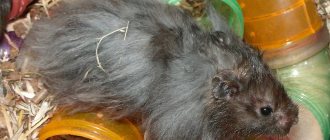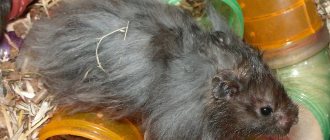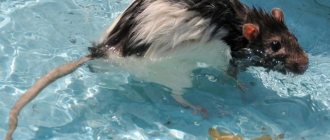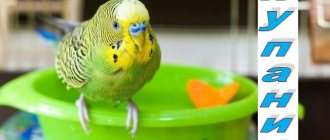The hamster is one of the cutest and friendliest pets. The hilarious behavior of this animal, its funny face and beautiful fur evoke affection in both children and adults.
Those who decide to have a rodent in their home need to study the rules for caring for it in advance. One of the key questions is how to wash a hamster?
Actually, I’m white... Well, that’s how it happened!
The dangers of frequent bathing for hamsters
Frequent bathing greatly shortens the life of a pet. Hamsters don't like water. They are not adapted to stay in liquid, even if it is short-term. Their fur is not thick and dense enough for rodents to quickly warm up. The hairs are not covered with water-repellent secretion.
The protective layers of the skin are delicate, so even after drinking water there is a risk of health problems. Additionally, water procedures can cause injury.
Stress when immersed in water
Hamsters can't swim. For them, immersion in liquid is fraught with death, especially if there is no way to stand on their paws. In water, the animal loses control over the situation; it has no chance to escape without the help of its owner. For this reason, rodents become very nervous. They break out, bite and cling to clothing. Under extreme stress, a heart attack can occur. Even if the pet survives, sometimes after shock it refuses water and food, becomes lethargic, and hides in shelters. In severe cases, the rodent becomes exhausted and dies.
Risk of hypothermia
Hamsters are not adapted to swimming. Their anatomical features do not provide protection from liquids. Trying to wash your pet can result in hypothermia, weakened immunity and pneumonia. Some owners, realizing this, try to dry the animal's fur with a hairdryer. You can't do that. The device frightens the pet, which increases stress. Excessively hot air can cause injury.
Trying to wash your pet can lead to hypothermia.
Violation of the protective layer of the skin
Since hamsters in the wild do not have to deal with water often, the protective layer on their skin is delicate, unstable, and easily destroyed. The liquid partially washes it away, which weakens the animal’s immunity. Due to the lack of a protective layer, skin problems arise. There is a possibility of hair loss.
Bathing with detergents is the most dangerous, especially if we are not talking about a special shampoo for hamsters, but about human shampoo.
Possible injury
The animal, sensing danger, instinctively breaks out and bites. If the owner drops the pet, the latter will fall either into the water or onto the floor. In the first case, the rodent swallows water and may drown. In the second, there is a risk of damage to internal organs and the spine. This can lead to the death of the animal.
Sand bath
A good alternative to water procedures is a sand bath: take a small container and fill it 2–3 cm with fine sand. The smallest particles will act as an abrasive, removing everything unnecessary and unnecessary from the fur: leftover food, feces, simple dirt. The sand is mixed under the hamster’s paws, thus “renewing” it, and the animal is cleansed with a clean substance.
As hamster owners say, these rodents have a very clean, soft and shiny skin after taking sand baths.
A sand bath is in many ways safer than a water bath, but a rodent cannot “swim” in it too often.
Hamsters can take sand baths much more often than water baths, but not more than once a week. This is due to the fact that tiny particles enter the lungs through the nose and settle there. Of course, they are gradually eliminated, but too frequent procedures can create big problems with the rodent’s respiratory system.
A container with sand should be placed in the cage when the animal is not sleeping, for exactly half an hour. During this time, the hamster manages to cleanse himself and play enough and moves on to his other business. If you leave the bathtub in the cage, your pet will mistake it for a toilet and use it for that purpose. Then it will all end up on his fur coat, and he will have to wash off his waste (and especially its smell) with water.
When is bathing necessary?
Before swimming, the benefits and risks are first assessed. If the first one outweighs, the procedures are carried out.
You can bathe your hamster in the following situations:
- The rodent got dirty in some food products. We are talking about foods that are prohibited and potentially dangerous for the hamster, such as mayonnaise, honey or jam. While such substances are on the rodent's fur, it can lick them off during the process of self-cleaning. In large quantities, the products will cause poisoning or death of the pet.
- The pet has stained its fur with chemicals. This is an even more dangerous situation. Most often, disinfectants and detergents end up on rodent fur. When they enter the stomach, they not only cause poisoning, but also injure the delicate mucous membranes of the gastrointestinal tract. The risk of developing chronic pathologies increases.
- The animal has parasites. Hamsters are sometimes bothered by parasites and mites. This happens rarely, but the chance remains. In this case, it is better to wash your hamster than to allow it to suffer from bites and risk infection. For the procedures, a special anti-parasite shampoo is used.
You can bathe your hamster if the rodent has gotten dirty.
When can you do without washing?
You should not bathe your animal as a preventive measure or for your own peace of mind. Rodents do not need daily baths. They have no need to bathe in water; they cleanse themselves in other ways. Pets also do not experience pleasure from the process, so their quality of life will not deteriorate without the procedures.
There is no need to bathe if there is a bad odor. On the contrary, it may worsen the situation. Normally, your pet should not have any odor. The animal carefully cares for its fur, devoting several hours to it every day. Most often, the source of the unpleasant odor is bedding, bowls, stale food supplies, etc. In this case, it is enough to clean with water and a soft sponge.
An unpleasant odor from the pet itself is a sign of illness. Even if the animal has simply stopped caring for itself, you need to contact a veterinarian. The smell can also come from fur, secretions, etc. In this case, the situation is worse, since it is a symptom of a dangerous pathology. You should not bathe an animal if you suspect a disease: this will worsen the general condition and accelerate the course of the disease.
Sometimes rodent owners try to untangle matted fur during procedures. It does not help. Water doesn't make hair smooth enough. The tangle will be difficult to disassemble, which will increase the pet’s discomfort, as it will cause pain. It is safer and easier to carefully cut off matted fur.
Bathing will not help with the unpleasant odor.
Alternative to water treatments
Since washing your pet is dangerous and stressful, a hamster bath is a good alternative. By their nature, these animals are very clean, so they themselves are able to clean their fur by tumbling in the sand.
Bathing rods for rodents are sold in pet stores, but you can make them yourself from cardboard, a food container, a soap dish and other available materials. They need to be filled with very fine dry sand, which will have to be changed weekly. It is better not to leave the sandy bathing suit in the cage all the time, because the animal is capable of knocking it over or playing whale there. By the way, pet stores also sell cages with balconies that you can use for a sand bath.
The indisputable advantage of bathing suits is their complete safety. They do not drive the tiny pet into a state of panic, they do not make the fur wet and there is absolutely no chance of catching a cold. Therefore, we advise you to arrange sand baths for the crunch every day, and water baths only in case of emergency.
Now you know whether small rodents like to splash around in water. Considering their cowardice and poor health, give preference to sand baths. But if parasites appear on your pet, wash it carefully and dry it thoroughly with a towel!
Features of bathing for different breeds of hamsters
When bathing, you need to take into account the characteristics of different breeds. Some are more likely to encounter water, others almost never encounter large open sources, so their fear is genetic. Another problem is the anatomical structure. Dwarf hamsters are easier to injure, so you need to be especially careful with them.
Syrians
The Syrian hamster has difficulty with bathing. It should be washed as quickly as possible, but without a strong stream of water. The animal should not be allowed to swim even in a shallow container. Syrians have weak immunity, so they can become cold and get sick. If the animal is not afraid of noise, you can dry the fur with a hairdryer on low setting.
Otherwise, wrap your pet in a towel to quickly warm him up. At the same time, this will help remove excess liquid.
Dzungariki
Problems rarely arise with this breed, since bathing a dwarf hamster is not difficult. Some animals are even happy to be in the water. Representatives of the breed have short fur, so the risk of catching a cold is lower. After the procedures, remove any remaining moisture from the fur coat with a napkin or towel. The immunity of Djungarian hamsters is stronger than that of Syrian hamsters, but after bathing it is better to remove the cage from drafts.
Djungarians have strong immunity, so the risk of catching a cold when swimming is lower.
Matching
When breeding Syrian hamsters, the correct selection of a pair is important.
To do this, you must follow the following rules:
- select only healthy animals;
- bring together individuals of the same breed;
- avoid inbreeding;
- do not allow animals that suffer from obesity to mate;
- choose hamsters with a friendly disposition.
Mating of Syrian hamsters is best done on neutral territory, where the animals will not defend the right to ownership. You can also place the female in the cage with the male. This will prevent the female from showing excessive hostility, and the male will calmly approach her to mate.
How to properly wash a hamster at home
For the first time, it is recommended to call an assistant, since washing a hamster at home is not easy. He may try to slip out of his hands.
Preparing for a swim
Before bathing, it is recommended to check your pet's reaction to water. You can even try to train a rodent. To do this, carefully take it in your hand and bring it to the container. The water level should not be higher than the animal's paws. If your pet is under severe stress, squeaks, breaks out and bites, you will have to wash it with your fingers dipped in water without immersing it in a container.
What is necessary
For swimming you only need a container and towels. It is advisable to take a small piece of fabric and cover the bottom of the “bathtub” with it. Thanks to this, the hamster will not slide, which will make him a little calmer and partially prevent injury.
It is not recommended to use shampoo. It is difficult to wash it off well, especially if the animal is under severe stress. Incomplete removal of detergents from wool is fraught with poisoning.
In most cases, there is no strict need to use shampoo.
Bathing process
The hamster is placed in a container with a small amount of water. It is carefully washed with your fingers, wetting the dry areas of the coat. If the animal is accustomed to a brush, you can use it. The areas of the ears, eyes and head should be avoided. When fluid gets into the ear cavity, otitis media develops.
The bathing process takes place in a small container.
It is forbidden to rub vigorously or use a rough sponge during the process. This can injure your pet. At best, you will damage his skin and provoke the development of dermatitis, at worst, you will injure him. You need to hold the hamster not too tightly, but not too weakly either: the animal can escape.
Drying the animal
After bathing, the hamster is dried with a soft cloth. It is carried out along the direction of hair growth. The animal is then wrapped in a dry towel and kept there until completely dry.
It is advisable to keep your pet busy with treats to reduce stress levels.
Drinking fountain
Such a device can serve not only to quench the thirst of animals, but also become an original accent in the home interior. The design consists of a water bowl, a filter, a diffuser and a drinking bowl located at the top. Additionally, it is equipped with a decorative sprinkler, especially popular with native breeds (Maine Coons, Kuril Bobtails, Siberian cats).
Continuous circulation of liquid is ensured by a mini-pump powered by a USB cable. More advanced models may contain backlighting and an indication of the level of remaining water in the tank.
Cost – 2400 rub.
Rodents bathing in the sand
Sand bathing is the safest and most natural alternative. The material cleanses wool well from stubborn dirt. During the bathing process, the pet experiences pleasure. The material is not capable of harming the animal.
For swimming you need to buy special sand. It must be intended for hamsters. You should not buy sand for chinchillas: it is fine-grained, so it can get into the animal’s respiratory tract. It also does a worse job of cleaning hamsters' fur.
A small amount of sand is poured into a container and placed in the cage. After this, the hamster will become interested in the new product and begin to bathe. After cleaning is completed, the container is removed. Otherwise it will turn into 2 toilets.
Summary
So, is it possible to wash hamsters with water? The answer is yes, but quickly, very carefully and only in extreme cases. In general, bathing procedures should be avoided, since neither the Dzungarians nor the Syrians are adapted to them (the latter in particular). To wash your hamster, use special sand from a pet store - this will almost always be enough.
Do you have any questions? Be sure to ask them in the comments, we will add the answers to the article. And subscribe to notifications about updates, otherwise you will miss a lot of interesting things!
How to Clean a Hamster Using Cotton Pads or Wipes
The use of napkins is not recommended. They may contain chemicals, including alcohol and fragrances, that can be harmful to rodents. The unnatural odor left behind by the wipes causes stress in animals.
Cotton pads are a neutral option. They are moistened with water and passed over the contaminated area, carefully adjusting the pressure. This method causes less stress for pets who are afraid of classic baths. After the procedure, the wool must be dried to prevent disease due to weakened immunity.
Drinking fountain
Such a device can serve not only to quench the thirst of animals, but also become an original accent in the home interior. The design consists of a water bowl, a filter, a diffuser and a drinking bowl located at the top. Additionally, it is equipped with a decorative sprinkler, especially popular with native breeds (Maine Coons, Kuril Bobtails, Siberian cats).
Continuous circulation of liquid is ensured by a mini-pump powered by a USB cable. More advanced models may contain backlighting and an indication of the level of remaining water in the tank.
Cost – 2400 rub.











